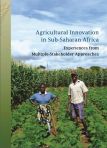 Last week, the crop residue trade-offs project team met in Addis Ababa to take stock of the data collected across all four regions (South Asia, Southern Africa, West Africa and East Africa). The idea was to see how we could build on and use the data collected towards practical solutions on how residues could be used better for livelihoods and the environment. Another key discussion point was about how the research momentum on crop livestock systems built up during the lifetime of the CGIAR Systemwide Livestock Program (SLP) could help to shape the new CGIAR Consortium Research Programs (CRPs), especially the ‘system CRPs’,1.1 and 1.2, which are meant to integrate research results from all other CRPs).
Last week, the crop residue trade-offs project team met in Addis Ababa to take stock of the data collected across all four regions (South Asia, Southern Africa, West Africa and East Africa). The idea was to see how we could build on and use the data collected towards practical solutions on how residues could be used better for livelihoods and the environment. Another key discussion point was about how the research momentum on crop livestock systems built up during the lifetime of the CGIAR Systemwide Livestock Program (SLP) could help to shape the new CGIAR Consortium Research Programs (CRPs), especially the ‘system CRPs’,1.1 and 1.2, which are meant to integrate research results from all other CRPs).
The workshop included representatives from the four regions where SLP works as well as guests from different institutions: CIMMYT (International Maize and Wheat Improvement Center), ICARDA (International Center for Agricultural Research in the Dry Areas), ICRISAT (International Crops Research Institute for the Semi-Arid Tropics), IITA (International Institute of Tropical Agriculture), ILRI (International Livestock Research Institute), the University of Minnesota in the US and finally from Wageningen University in the Netherlands.
Taking stock of phase I
Phase I of the crop residue trade-offs project developed a description of residue use and identified determinants of use and potential effects of different uses for livelihoods and the environment. This was based on a socio-economic analysis of 12 study sites across the SLP regions, based on village and household level surveys. The first day of the workshop included an update on the progress of each region, identification of major lessons on both process and content and an overview on the current data analyses. Most regions have finished data entry and are busy cleaning data from errors and missing information.
General lessons are: residues are mostly grazed or fed; trade-offs depend on both production and demand, but they are still more evident in low intensive agricultural sites; the participation of farmers and other stakeholder is essential to identify potential Technological, Institutional and Policy options (TIPs). Regional reports should be ready by end of March 2012. These will include a general descriptive analysis, as well as simple econometric approaches to identify determinants of crop residue use.
From diagnosis to action: phase II
Phase II aims to identify promising TIP options to reduce trade-offs in crop residue use. A consultation with external ‘experts’ and unfolding SLP internal discussions seemed to agree that a more participatory approach will bridge the diagnostic phase I into a more practical phase II. The SLP does not have either the resources or the long term timeframe to embark on action research, therefore phase II should be seen as a transition phase that can help link SLP research to ongoing and new projects or to develop new proposals to go beyond diagnosis.
On the last day of the workshop, we started with a description of CRP 1.1 and 1.2 and went on to discuss how SLP can share some experience on systems research and institutional collaboration, which have been major SLP principles. Additionally, a work plan for 2012 for Phase II was mapped out. Phase II will focus on well-defined consultations with farmers and other stakeholders in the different regions to identify promising TIPs, and to enrich the already quantitative description of crop residue uses and trade-offs with a more qualitative analysis across study sites and households in mixed crop-livestock systems.
This workshop marked the beginning of the last year of the SLP and the crop residue trade-offs project. We hope to keep enriching the research of the CGIAR centers and projects with experiences in system analysis and intra-CGIAR collaboration. We also plan to make full use of the time remaining to move into a more action-oriented mode. We will identify promising TIPs that will tackle trade-offs in biomass use to the benefit of the livelihoods of the rural poor and the long term sustainability of rural regions in the developing world.




